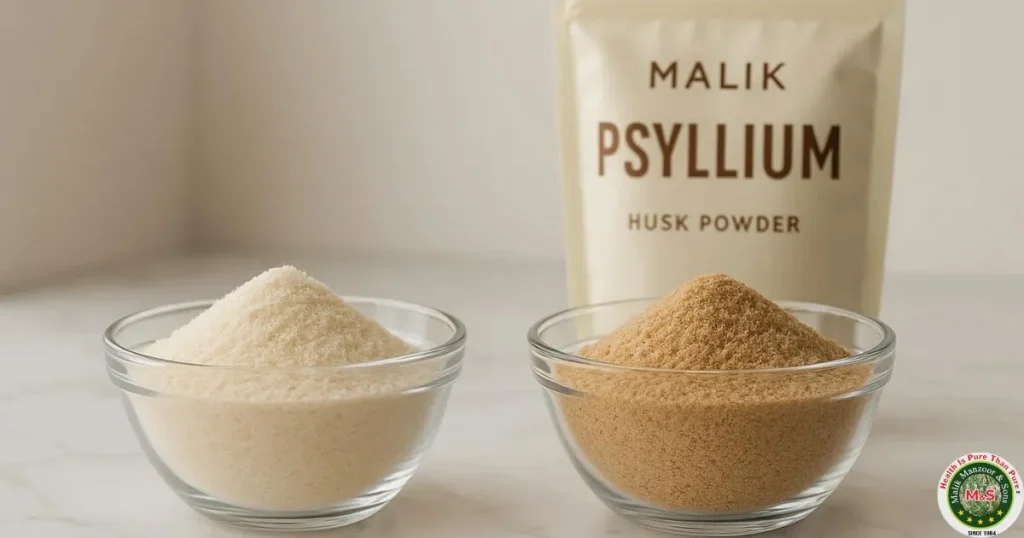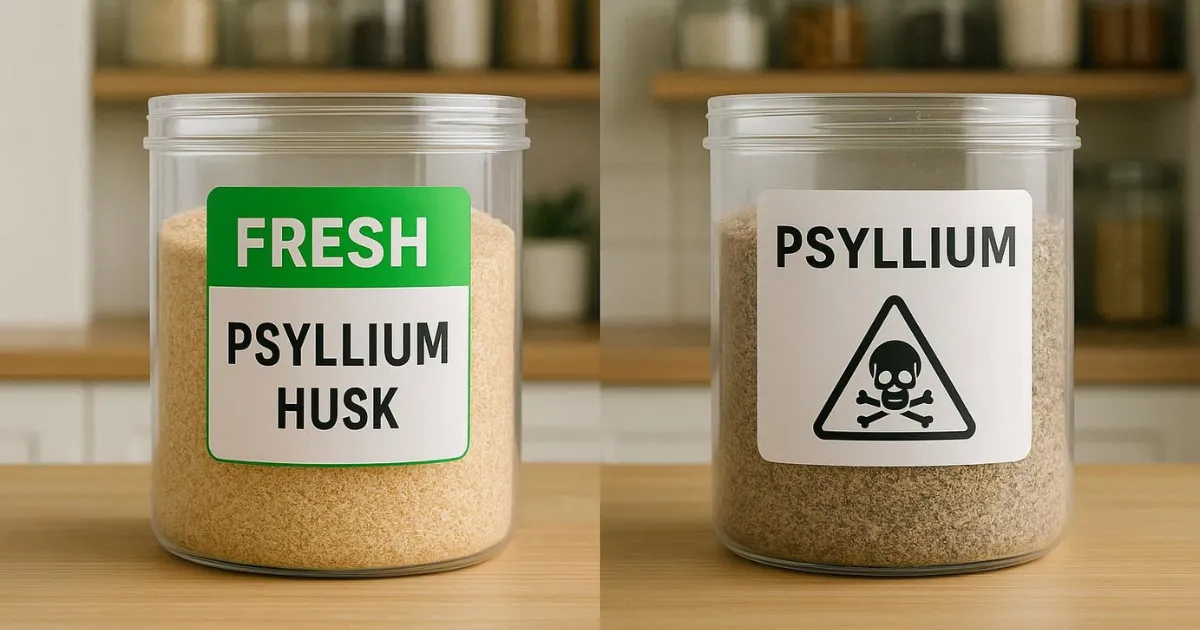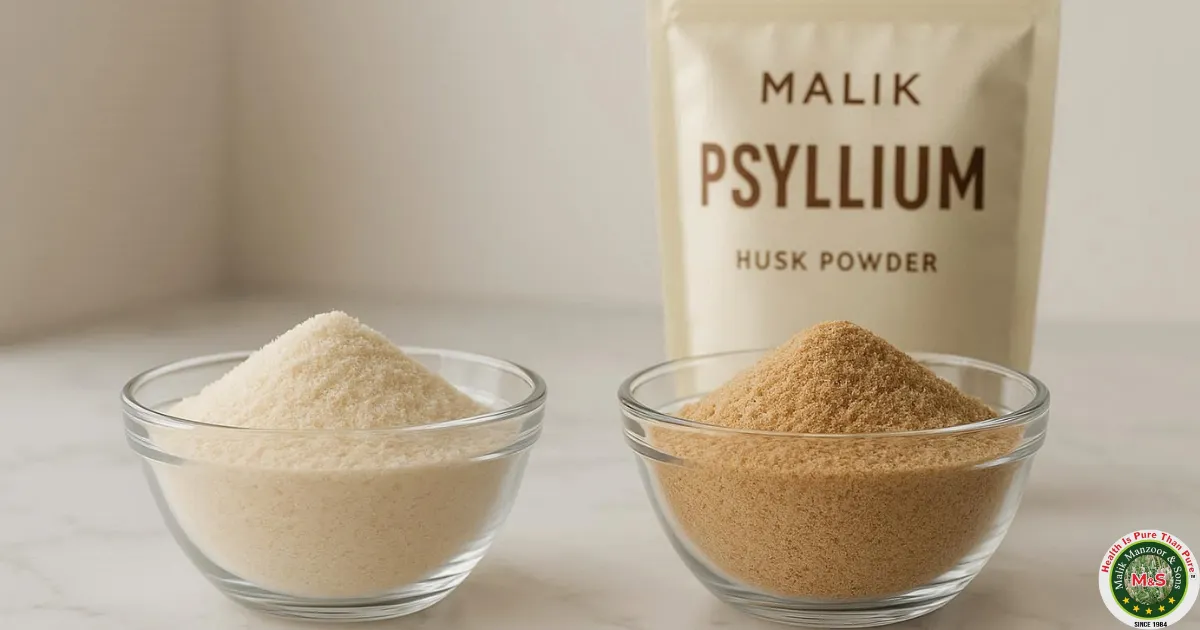Blond Psyllium Husk Powder vs Ground Psyllium Husk Powder: Complete Guide to Types, Benefits & Uses

When browsing fiber supplements or gluten-free baking ingredients, you’ve likely encountered terms like blond psyllium husk powder and ground psyllium husk powder. Are they the same thing? Do they work differently? Which one should you choose for your specific needs? These questions matter because selecting the right type of psyllium can significantly impact your health goals and recipe outcomes.
Understanding the differences between blond psyllium husk powder and ground psyllium husk powder helps you make informed decisions whether you’re managing digestive health, experimenting with gluten-free baking, or supporting your wellness routine. This comprehensive guide explores both types, their unique characteristics, applications, and how to use them effectively for maximum benefits.
What Is Blond Psyllium Husk Powder
Blond psyllium husk powder comes from the pale, outer coating of Plantago ovata seeds. The term “blond” refers to its light cream or beige color, distinguishing it from darker varieties. This specific type undergoes processing to remove the seed and grind the husk into fine powder form.
The blond variety is considered superior for several reasons. Its lighter color makes it virtually invisible in recipes, particularly important for baking, where appearance matters. The pale hue indicates higher purity with minimal seed content, resulting in better gel-forming properties. Blond psyllium husk powder contains approximately 70-80% soluble fiber, making it exceptionally effective for digestive health and binding applications.
This powder form dissolves more readily than whole husks, creating a smooth gel when mixed with liquid. The fine texture allows for easier incorporation into foods and beverages without gritty residue. Most commercial fiber supplements and baking recipes specifically call for blond psyllium husk powder because of its consistent performance and neutral appearance.

Understanding Ground Psyllium Husk Powder
Ground psyllium husk powder represents a broader category that includes any psyllium husk milled into powder form, regardless of color or refinement level. This can include blond varieties, darker brown versions, or mixtures containing varying amounts of seed material.
The grinding process breaks down whole psyllium husks into smaller particles, creating powder with different coarseness levels depending on processing methods. Ground psyllium husk powder may contain more seed material than refined blond varieties, giving it a darker appearance and slightly different nutritional profile.
This type works similarly to blond psyllium husk powder in terms of fiber content and health benefits, but may have subtle differences in texture and appearance. Ground versions often cost less than highly refined blond powder, making them attractive for bulk use or situations where color doesn’t matter.
The key distinction lies in the refinement level. While all blond psyllium husk powder is ground, not all ground psyllium husk powder is blond. Understanding this difference helps you choose the right product for specific applications, from therapeutic use to culinary experimentation.
Key Differences Between Blond and Ground Psyllium Husk Powder
Several important factors distinguish these two types. Color represents the most obvious difference. Blond psyllium husk powder features light cream or beige tones, while ground psyllium husk powder ranges from light tan to dark brown depending on seed content and processing.
Purity levels vary significantly. Blond psyllium husk powder typically contains 95-99% pure husk with minimal seed material. Ground psyllium husk powder may include more seed particles, reducing overall purity but potentially adding nutritional elements like protein and healthy fats.
Texture consistency differs between types. Blond husk powder is usually milled to a finer consistency for smooth dissolution. Ground husk powder may have coarser particles depending on processing, affecting how it mixes with liquids and incorporates into recipes.
Gel formation properties show subtle variations. Blond psyllium husk powder creates clearer, more consistent gels ideal for baking and supplements. Ground psyllium husk powder forms similar gels but may produce a slightly grittier texture or a darker color in final products.
Price points reflect refinement levels. Blond psyllium husk powder generally costs more due to additional processing and higher purity. Ground psyllium husk powder offers more affordable options while delivering comparable health benefits, making it suitable for budget-conscious consumers.

Health Benefits of Both Types
Both blond psyllium husk powder and ground psyllium husk powder deliver impressive health benefits thanks to their high soluble fiber content. Understanding these advantages helps you appreciate why psyllium has become a staple in wellness routines worldwide.
Digestive health improvement stands as the primary benefit. Both types absorb water in the intestines, forming bulk that promotes regular bowel movements. This helps relieve constipation naturally without harsh laxatives. The gel-like consistency also soothes intestinal walls, potentially reducing inflammation and supporting overall gut health.
Cholesterol management represents another significant advantage. Soluble fiber from both blond and ground psyllium husk powder binds to cholesterol in the digestive system, helping remove it before absorption. Regular consumption may lower LDL cholesterol levels while maintaining beneficial HDL cholesterol, supporting cardiovascular health.
Blood sugar regulation benefits diabetics and those managing glucose levels. The fiber in both types slows carbohydrate absorption, preventing sharp blood sugar spikes after meals. This creates more stable energy levels throughout the day and may improve long-term glycemic control.
Weight management support comes from increased satiety. Both forms expand in the stomach, creating fullness that reduces appetite and calorie intake. This makes them valuable tools for those pursuing healthy weight loss without feeling constantly hungry.
Heart health protection extends beyond cholesterol management. The anti-inflammatory properties and blood pressure regulation associated with high-fiber diets make both blond and ground psyllium husk powder beneficial for overall cardiovascular wellness.
How to Use Blond Psyllium Husk Powder
Blond psyllium husk powder excels in applications where appearance and smooth texture matter. For daily fiber supplementation, mix one teaspoon to one tablespoon in eight ounces of water, juice, or smoothie. Stir vigorously and drink immediately before the mixture thickens.
In gluten-free baking, blond psyllium husk powder acts as a binder that mimics gluten’s elasticity. Use one to three teaspoons per cup of gluten-free flour blend, adjusting based on recipe requirements. The light color won’t darken baked goods, maintaining an appealing appearance in breads, muffins, and pastries.
For therapeutic purposes, take blond psyllium husk powder thirty minutes before meals with plenty of water. This timing maximizes satiety benefits and supports digestive regularity. Start with smaller amounts like one teaspoon daily, gradually increasing to avoid digestive discomfort.
When using trusted sources like Malik Psyllium, you ensure consistent quality that delivers reliable results across all applications. Premium-grade blond psyllium husk powder maintains its effectiveness whether you’re supporting digestive health or perfecting gluten-free recipes.
Create a morning wellness drink by mixing one tablespoon of blond psyllium husk powder with lemon water and a touch of honey. This refreshing beverage kickstarts digestion and provides sustained energy without caffeine jitters.
How to Use Ground Psyllium Husk Powder
Ground psyllium husk powder works wonderfully when color matters less and cost-effectiveness is the priority. For basic fiber supplementation, follow the same mixing ratios as the blond variety, using one teaspoon to one tablespoon in liquids.
In hearty baked goods like whole grain breads, muffins with nuts and seeds, or dark chocolate brownies, ground psyllium husk powder provides excellent binding without aesthetic concerns. The slightly darker color blends seamlessly into these recipes while delivering the same structural benefits.
For bulk smoothie preparation or protein shake enhancement, ground psyllium husk powder offers economical fiber boosting. Add one to two teaspoons per serving, blending thoroughly to prevent clumping. The fiber complements protein powder and helps maintain fullness between meals.
Use ground psyllium husk powder in savory applications like veggie burgers, meatloaf, or coating mixtures. The binding properties help ingredients stick together, while the darker color integrates naturally into these dishes.
When making large batches of gluten-free flour blend for regular baking, ground psyllium husk powder provides a cost-effective fiber addition. Mix it into your base flour combination and store in airtight containers for convenient access.
Blond vs Ground Psyllium Husk Powder in Baking
Baking applications highlight the practical differences between these types. Blond psyllium husk powder reigns supreme for delicate pastries, white breads, vanilla cakes, and light-colored baked goods where appearance matters. Its pale color preserves the intended shade of final products.
The finer texture of blond psyllium husk powder distributes more evenly through batters and doughs, creating a consistent structure throughout. This results in better rise, improved crumb texture, and more professional-looking results that rival traditional wheat-based baked goods.
Ground psyllium husk powder works perfectly for rustic breads, dark rye loaves, chocolate desserts, and hearty muffins, where deeper color enhances appeal. The slightly coarser texture may create a more artisanal appearance in crusty breads, adding to their authentic character.
Both types provide the elasticity and binding that gluten-free baking desperately needs. They trap gases produced by leavening agents, helping breads rise properly. The moisture retention extends shelf life, keeping baked goods fresh longer than recipes without psyllium.
For pizza dough and flatbreads, either type works well depending on the desired appearance. Blond psyllium husk powder creates a lighter-colored crust similar to traditional pizza, while ground psyllium husk powder produces a darker, more rustic appearance.

Comparison Table: Blond vs Ground Psyllium Husk Powder
Color & Appearance
Blond: Light cream/beige, nearly invisible in recipes
Ground: Tan to brown, more visible in light-colored foods
Purity Level
Blond: 95-99% pure husk, minimal seed content
Ground: Variable purity, may contain more seed material
Texture Fineness
Blond: Very fine powder, smooth consistency
Ground: Potentially coarser, varies by processing
Best Applications
Blond: Delicate baking, supplements, light recipes
Ground: Hearty baking, budget use, dark recipes
Price Range
Blond: Higher cost due to refinement
Ground: More affordable, cost-effective option
Gel Clarity
Blond: Creates clear, smooth gel
Ground: Forms gel with possible cloudiness
Flavor Impact
Blond: Completely neutral taste
Ground: Subtle, barely detectable difference
Nutritional Comparison
Both blond psyllium husk powder and ground psyllium husk powder offer impressive nutritional profiles dominated by dietary fiber. Understanding the slight differences helps optimize your supplement choices.
A typical tablespoon of blond psyllium husk powder contains approximately 30-35 calories, with 7-8 grams of total fiber, nearly all soluble. Protein content remains minimal at less than one gram, while fat content is negligible. Carbohydrate content appears high at 8-10 grams, but most comes from fiber that doesn’t impact blood sugar.
Ground psyllium husk powder shows similar nutritional values with potential variations. If it contains more seed material, protein and fat content may be slightly higher while maintaining comparable fiber levels. The additional seed components add trace minerals like magnesium, zinc, and iron.
Both types provide zero cholesterol, zero sodium, and no artificial additives when sourced from quality suppliers. The primary nutritional value comes from soluble fiber that supports multiple body systems simultaneously.
Vitamin and mineral content remains minimal in both types, as psyllium is primarily a fiber source rather than a micronutrient provider. However, the digestive benefits enable better absorption of nutrients from other foods consumed throughout the day.
For those tracking macronutrients, the fiber in both blond and ground psyllium husk powder doesn’t count toward net carbs in ketogenic diets. This makes both types valuable for low-carb eaters seeking additional fiber without carbohydrate concerns.
Digestive Health Applications
Both blond psyllium husk powder and ground psyllium husk powder excel at supporting digestive wellness through multiple mechanisms. Their soluble fiber content addresses various gastrointestinal concerns effectively.
For constipation relief, both types work by absorbing water and swelling in the intestines. This creates soft, bulky stools that pass more easily, providing gentle relief without cramping or urgency. Take one tablespoon mixed in water before bed for overnight results, or split the dosage throughout the day.
Diarrhea management benefits from the absorbent properties of both forms. The fiber absorbs excess water in the digestive tract, helping firm loose stools while maintaining hydration. Start with half tablespoon doses and adjust as symptoms improve.
Irritable bowel syndrome sufferers find relief with both types by regulating bowel movements and reducing intestinal inflammation. The gel-like consistency soothes irritated intestinal walls while normalizing transit time regardless of whether constipation or diarrhea predominates.
Hemorrhoid prevention and relief comes from softer stools that reduce straining. Both blond and ground psyllium husk powder make elimination more comfortable, allowing hemorrhoids to heal while preventing new ones from forming.
Gut microbiome support happens as both types serve as prebiotics, feeding beneficial bacteria. This improves overall gut health, enhances immune function, and may reduce inflammation throughout the body.
Expert Tips for Maximum Effectiveness
As someone who has worked extensively with psyllium products, I’ve learned several strategies that dramatically improve results. Starting slowly remains crucial regardless of which type you choose. Begin with one teaspoon daily and gradually increase over two weeks to avoid bloating, gas, or cramping.
Hydration can not be overemphasized when using either blond or ground psyllium husk powder. Drink at least eight ounces of liquid per tablespoon of powder, with additional water throughout the day. Insufficient fluid intake can cause uncomfortable binding or even intestinal blockage in extreme cases.
Timing significantly impacts effectiveness. Take psyllium thirty minutes before meals for appetite control and blood sugar management. For digestive regularity, bedtime dosing works well. Avoid taking psyllium simultaneously with medications, as it may interfere with absorption. Space them at least two hours apart.
Consistency delivers better results than sporadic use. Make psyllium part of your daily routine rather than an occasional supplement. Benefits accumulate over time, with optimal effects appearing after several weeks of regular consumption.
Storage matters for maintaining potency. Keep both types in airtight containers away from moisture, heat, and direct sunlight. Properly stored psyllium maintains effectiveness for years, while exposure to humidity causes clumping and reduces quality.
Mix thoroughly and consume promptly when preparing psyllium drinks. Both blond and ground psyllium husk powder begin gelling within minutes of contact with liquid. Drink mixtures immediately after stirring to avoid an unpleasant thick consistency.
Common Mistakes to Avoid
Many people unknowingly sabotage their psyllium experience through preventable errors. Using insufficient liquid ranks as the most common mistake. Both blond and ground psyllium husk powder need adequate hydration to function properly. Skimping on water leads to uncomfortable bloating and reduced effectiveness.
Taking too much too quickly causes digestive distress. Enthusiastic beginners often start with multiple tablespoons daily, resulting in gas, cramping, and discomfort. Gradual introduction allows your digestive system to adapt while minimizing side effects.
Mixing psyllium in hot beverages can be problematic. Heat accelerates gel formation, causing rapid thickening that makes consumption difficult. Use room temperature or cool liquids for the best mixing properties and a pleasant drinking experience.
Expecting instant results sets up disappointment. Both types require consistent use over days or weeks to show full benefits. Digestive improvements typically appear within 24-72 hours, but cholesterol and blood sugar benefits take longer to manifest.
Neglecting to read product labels carefully means you purchase the wrong type for your needs. If the recipe specifically calls for blond psyllium husk powder, substituting with a darker ground version may affect the appearance despite functional similarity.
Not adjusting recipes when switching between types can impact results. While functionally similar, blond and ground psyllium husk powder may behave slightly differently. Test small batches when substituting one for the other in established recipes.
Choosing Between Blond and Ground Psyllium Husk Powder
Several factors should guide your decision between these types. Consider your primary purpose first. For gluten-free baking where appearance matters, blond psyllium husk powder clearly wins. For budget-conscious bulk use or applications where color is irrelevant, ground psyllium husk powder makes more sense.
Dietary restrictions play a role. Both types suit vegan, vegetarian, and most special diets. However, if you have seed allergies, choose highly refined blond psyllium husk powder with minimal seed content. Those without sensitivities can use either type without concern.
Budget constraints influence many decisions. If cost is the primary concern and you’re using psyllium primarily for digestive health rather than baking, ground psyllium husk powder delivers comparable benefits at lower price points. Quality suppliers offer both options to suit different needs and budgets.
Personal preference regarding taste and texture matters. While both types are relatively neutral, some people detect subtle differences. Trial small quantities of each to determine which you prefer in your smoothies, beverages, or recipes.
Availability in your region may limit choices. Some areas have limited access to specialty products like highly refined blond psyllium husk powder. Ground psyllium husk powder appears more widely available, making it a practical default option in some locations.
Quality Considerations When Buying
Regardless of whether you choose blond psyllium husk powder or ground psyllium husk powder, quality determines effectiveness and safety. Look for products from reputable manufacturers who provide clear labeling about purity, processing methods, and source materials.
Organic certification indicates products grown without pesticides or synthetic fertilizers. While organic status doesn’t necessarily mean better fiber content, it appeals to those prioritizing clean agriculture and environmental sustainability.
Third-party testing provides assurance about purity and safety. Quality manufacturers submit products for independent laboratory analysis, checking for contaminants, heavy metals, and microbial issues. Look for brands that transparently share these test results.
Packaging matters more than many realize. Both types should come in moisture-resistant containers that protect against humidity and light. Clear labeling should include usage instructions, serving sizes, and any relevant warnings about medication interactions.
Country of origin information helps assess quality. India and Pakistan produce most of the world’s psyllium, with different regions known for varying quality levels. Established suppliers like Malik Psyllium source from premium growing areas, ensuring consistent excellence across product lines.
Recipes Using Blond or Ground Psyllium Husk Powder
Gluten-Free Sandwich Bread Combine 2 cups gluten-free flour blend, 2 tablespoons blond psyllium husk powder, 1 tablespoon sugar, 2 teaspoons yeast, and 1 teaspoon salt. Add 1.5 cups of warm water and 2 tablespoons of oil. Mix until smooth, let rise one hour, then bake at 375 ° F for 35-40 minutes. The blond variety keeps bread light-colored and fluffy.
Morning Fiber Smoothie Blend 1 cup almond milk, 1 frozen banana, 1 tablespoon ground psyllium husk powder, 1 tablespoon peanut butter, and handful of spinach. Add ice and blend until smooth. The ground powder provides fiber boost without affecting the smoothie’s color significantly.
Keto Pizza Crust Mix 1.5 cups mozzarella cheese, 2 tablespoons cream cheese, 1 egg, 0.75 cup almond flour, and 1 tablespoon blond psyllium husk powder. Form into a crust, bake at 425 ° F for 10 minutes, add toppings, and bake additional 10 minutes. Blond psyllium creates a perfect chewy texture.
Chocolate Protein Balls Combine 1 cup dates, 0.5 cup cocoa powder, 0.5 cup oats, 2 tablespoons ground psyllium husk powder, and 2 tablespoons honey. Roll into balls and refrigerate. Ground psyllium works perfectly here since cocoa masks any color difference.

Pros and Cons of Blond Psyllium Husk Powder
Pros:
- Nearly invisible in light-colored recipes
- Higher purity level with minimal seed content
- Creates exceptionally smooth gel consistency
- Perfect for delicate baking applications
- Consistently fine texture for easy mixing
- Premium appearance in finished products
Cons:
- Higher cost due to additional refinement
- May be harder to find in some locations
- Functionally similar to the ground version despite the price difference
- Minimal nutritional advantage over quality ground powder
- Overkill for applications where appearance doesn’t matter

Pros and Cons of Ground Psyllium Husk Powder
Pros:
- More affordable for regular use
- Widely available in most markets
- Delivers the same health benefits as the blond variety
- May contain trace additional nutrients from seeds
- Perfect for budget-conscious consumers
- Works excellently in dark or rustic recipes
Cons:
- Darker color affects appearance in light recipes
- Potentially coarser texture depending on processing
- Variable purity levels across different brands
- May create a cloudier gel compared to the blond type
- Less ideal for professional baking presentations
Can I use ground psyllium husk powder instead of blond psyllium husk powder in recipes?
Yes, ground psyllium husk powder works as a substitute for blond psyllium husk powder in most recipes. Use the same measurements, though be prepared for slightly darker color in light-colored baked goods. Functionality remains virtually identical for binding and moisture retention.
Is blond psyllium husk powder better than ground psyllium husk powder for constipation?
Both types are equally effective for relieving constipation since they contain similar levels of soluble fiber. The difference lies in appearance and refinement, not therapeutic effectiveness. Choose based on personal preference and budget rather than constipation-fighting ability.
How much blond psyllium husk powder should I take daily?
Start with one teaspoon daily and gradually increase to one tablespoon once or twice daily as tolerated. Always consume with at least eight ounces of water per tablespoon. Optimal dosage varies by individual needs and health goals, so adjust based on your response.
Does ground psyllium husk powder have more nutrients than blond?
Ground psyllium husk powder may contain slightly more protein and trace minerals if it includes more seed material, but differences are minimal. Both types primarily provide fiber rather than significant vitamins or minerals. Choose based on intended use rather than minor nutritional variations.
Can I take blond psyllium husk powder with medications?
Take psyllium at least two hours before or after medications to avoid interference with absorption. Both blond and ground types can bind to certain medications, reducing their effectiveness. Consult your healthcare provider about timing if you take prescription medications regularly.
What’s the best way to store both types of psyllium husk powder?
Store both blond and ground psyllium husk powder in airtight containers in cool, dry places away from direct sunlight. Moisture is the primary enemy, causing clumping and reducing quality. Properly stored, both types maintain effectiveness for years without refrigeration.
Final Thoughts
Both blond psyllium husk powder and ground psyllium husk powder offer exceptional health benefits and practical applications in cooking and baking. The choice between them ultimately depends on your specific needs, budget, and intended use. Blond psyllium husk powder excels when appearance matters, providing invisible fiber support for delicate recipes and supplements. Ground psyllium husk powder delivers comparable health benefits at a lower cost, making it ideal for regular use and applications where color is irrelevant.
Understanding the subtle differences empowers you to make informed decisions that align with your wellness goals and lifestyle preferences. Whether you prioritize baking perfection or cost-effective daily fiber supplementation, both types deserve a place in health-conscious kitchens.
Malik Shabbir
Featured Blogs

Expired Psyllium Husk Powder: Safety, Shelf Life & When to Discard It
You’re cleaning out your pantry and discover a container of

Blond Psyllium Husk Powder vs Ground Psyllium Husk Powder: Complete Guide to Types, Benefits & Uses
When browsing fiber supplements or gluten-free baking ingredients, you’ve likely
